(5253 products available)



















































































































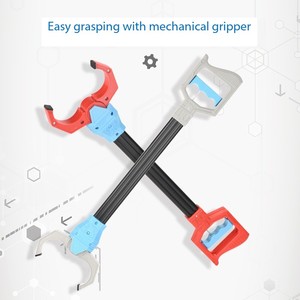
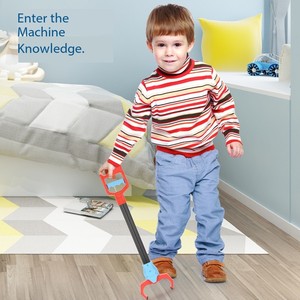
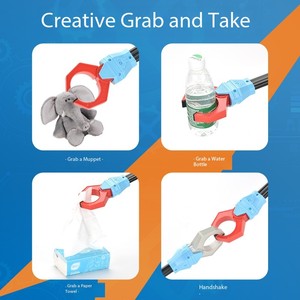
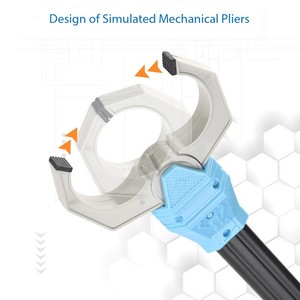
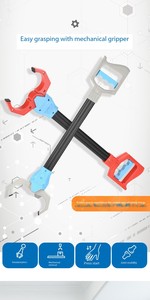





























































































A robot hand toy comes in different types, including:
Mechanical Robot Hand Toys
Mechanical robot hand toys are simple and easy to use. They use levers and pulleys to make the fingers move. By pulling on a wire or pressing a lever, all the fingers move. This makes them great for kids just starting to play with robots. They are also very strong. Kids can grab things with the robot hand. It does not break easily. Mechanical robot hands are very cheap too. However, they do not move like real human hands. The movements are not smooth.
Pneumatic and Hydraulic Robot Hand Toys
Pneumatic and hydraulic robot hand toys use air and water pressure. With these robot hands, the air or water pressure makes the fingers move. A small pump is used to push air or water into the hand. When a child presses a button, the pump sends air or water to different parts of the hand. This makes different finger movements possible. The robot hand can wave, point, or pick up things. It can do many things because the movements are smooth and flexible. However, these robot toys are more difficult to fix when they break. This is because they have pipes that carry air and water. The pipes can tear easily, causing the robot hand to stop working.
Electronic Robot Hand Toys
Electronic robot hand toys are controlled by a computer. A small computer called a microcontroller is put inside the robot hand. The microcontroller sends messages to the motors and sensors inside the hand. This makes it possible to control the robot hand in many ways. A child can program the robot hand to move in any way. The robot hand becomes a learning tool. Children learn how to code and program computers. However, electronic robot hand toys are very expensive. There are many parts, and each part costs money.
Programmable Robot Hand Toys
Programmable robot hand toys are the most advanced. They let a child control the robot hand with a smartphone or tablet. Using a special app, a child can tell the robot hand what to do. The child can choose different movements, and the robot hand will do them. This makes playing with the robot hand fun and creative. Children can also learn how to code and program. However, programmable robot hand toys are very costly. They are also difficult to fix if they break.
When choosing a robot hand toy for sale, business owners should consider age appropriateness. Ideally, toys meant for younger kids should be less complicated and more durable. On the other hand, those meant for older kids should have more complex functions and be more fragile. Business owners should also get robot hand toys in various sizes. Normally, customers will purchase toys depending on their kids' preferences. Customers will also get robot hand toys with different levels of interactivity. Some will have basic movements controlled by the kid. At the same time, others will have advanced features like voice commands and sensors. Toys with advanced features are likely to be more expensive than those with basic functions.
Robot hand toys can be powered by batteries or use USB rechargeable batteries. Toys powered by batteries are convenient since they can be used anywhere. However, they require frequent battery replacements. On the other hand, toys with USB batteries are more economical since they can be recharged when the battery is low. Buyers should choose toys with the power option they think will be more convenient for their customers. Toys meant for younger kids are usually made of soft materials, while those meant for older kids are made of plastic or metal. Such toys can easily break into pieces when dropped. Therefore, buyers should get robot hand toys in various types of packaging. For instance, toys meant for younger kids should be packaged in secure and tamper-proof containers.
Business owners should also consider the robot hand toy's educational aspect. Toys that can help kids learn new things. For instance, STEM concepts are more valuable to parents. At the same time, they are more likely to attract attention. Robot hand toys, just like any other toys, come with various safety features. For instance, they have no small parts that can be a choking hazard for kids or sharp edges. Buyers should ensure the toys they get don't have toxic materials that can be hazardous to kids. Finally, buyers should consider the toy's price. Ideally, they should get robot hand toys in different price ranges.
Robot hand toys come in various designs, each offering unique functions and features to cater to different interests and age groups. Here are some common designs, along with their functions and features:
These are hands driven by mechanical linkages and cables, usually made of plastic or light metal. They are powered by either electric or manual means. They come with cables and pulleys that are used to control the hand movements, imitating a human hand's gestures such as grasping and waving.
These hands are meant for learning purposes and are often created for students. They come with DIY assembly instructions and usually include components like servo motors, sensors, and microcontrollers. They assist learners in grasping the basics of robotics, coding, and engineering by allowing them to build a functioning robotic hand.
These toys come with programmable features that enable users to code hand movements. They come with a programmable interface that uses visual programming languages or block-based coding. They are meant for learners who need to be taught about coding and robotics. They allow users to create custom sequences of movements and actions.
These toys come with puppet-like hands that can be used for storytelling and imaginative play. They have a hand that is a puppet; thus, they have a hollow robotic hand that covers the child's hand. They come with movable fingers that are controlled by the puppet's hand, and they can have voice boxes or sound effects. They are meant for creative play and come with customizable features like interchangeable accessories and costumes.
These hands are developed to assist children with disabilities or to improve their fine motor skills. They are lightweight and come with sensors that detect muscle movements or hand gestures. They are controlled wirelessly through an app or a remote, allowing for customizability in terms of sensitivity and response.
When choosing a robotic hand toy for a child, it is crucial to consider various safety features to ensure the toy is safe for use. Here are some essential safety features:
Non-Toxic Materials
The toy should be made from non-toxic, BPA-free plastics and materials that are safe for children to touch and handle.
Soft Edges
Ensure the toy has rounded edges and soft contours to prevent cuts or injuries during play.
Battery Compartment
A secure, closed battery compartment that requires a tool to open can help prevent children from accessing batteries, which can be harmful if ingested.
Heat Protection
If the toy uses motors or batteries, it should have adequate ventilation and cooling systems to prevent overheating and burns.
Choking Hazard Prevention
The robotic hand should be large enough to prevent choking hazards. Small parts should be avoided or securely attached to the toy.
Sturdy Construction
The robotic hand toy should be well-built and sturdy to endure rough play without breaking apart or exposing sharp edges.
Compliance with Safety Standards
The toy should comply with recognized safety standards, such as ASTM (American Society for Testing and Materials) or EN71 (European Standard for Toy Safety).
When assessing the quality features of a robotic hand toy, several factors contribute to an overall high-quality product. Here are some key features to consider:
Build Quality
The robotic hand toy should be well-constructed using durable materials, typically high-quality plastics or soft-touch silicone. Also, the joints and movements should be smooth and precise, with no loose parts.
Safety
The materials used to make the toy should be non-toxic and free from harmful chemicals like lead and phthalates. Also, the edges should be rounded, and small parts should be large enough to prevent choking hazards.
Educational Value
The toy should offer learning opportunities in STEM fields, improving fine motor skills, or enhancing creativity and imagination. It should also come with apps that should be well-designed, user-friendly, and compatible with various devices.
Q1. What are the benefits of robot hand toys?
A1. Robot hand toys help improve hand-eye coordination and fine motor skills. This is because children manipulate and control the robotic hand's movements and gestures. The activity engages the child's hand and finger muscles, promoting strength and dexterity. It is beneficial for activities like writing, drawing, or playing a musical instrument.
Q2. How can buyers ensure the robot hand toy is safe?
A2. To confirm the safety of robot hand toys, examine the certifications, read reviews, and check the manufacturer's details. Such toys should be free of harmful chemicals like lead, phthalates, and BPA and be constructed of sturdy but soft materials that are safe for children to play with. It also has no sharp edges or small parts that can be a choking hazard.
Q3. What educational value do robot hand toys provide?
A3. Robot hand toys have vast educational value as they introduce kids to the fundamentals of robotics, engineering, and coding in a playful and captivating manner. Children can learn about the basic concepts of robotics, including how joints and motors function, through the design and operation of robotic hands.
Q4. How do robot hand toys enhance creativity?
A4. Robot hand toys stimulate imagination by providing a flexible platform for creative thinking and expression. Children can customize their robotic hands with various attachments, colors, and accessories. This enables kids to personalize their creations, make them look cool, and improve their imaginative powers.
Q5. What features should buyers consider in a robot hand toy?
A5. Various features should be considered when choosing a robot hand toy, including adjustability, control options, educational value, safety, and durability. The robotic hand's design and construction should be adaptable to accommodate children's varying hand sizes and its components to be robust and long-lasting.